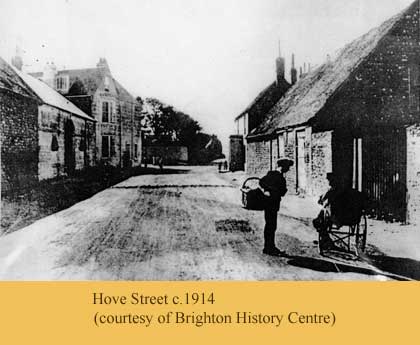





 STREET
LIFE
STREET
LIFE
Every street corner had a shop: in the immediate vicinity of Ellen Street
there were 2 bakers, a grocer, general stores, greengrocers and corn
chandlers. There were also 2 blacksmiths, one of which was the author’s
grandfather, and the noise of the red-hot metal being hammered into shape
on the anvil could be heard some distance away. All traffic was horse-drawn – there
were no cars – and on the seafront there were water-troughs and
stands for hansom cabs. Mrs King remembers once riding on the top of
a horse-drawn omnibus and looking down onto the horses’ gleaming
backs.
“
We had no tarmac’d roads then – it was all grit – and
in the hot weather the water cart came round and sprayed, and oh, it
was lovely when – the smell of the water on the hot stoney road,
and the boys all used to run behind to get splashed with water. That
was one of the summer memories.”
Mrs King vividly recalls the street vendors with their distinctive cries. There was always a muffin man on a regular basis; and a man selling fresh watercress in a big basket. Whenever there was a seasonal glut of anything, people would come round with barrows or hand-carts calling when the cherries were in, or locally caught herrings, winkles and shrimps. Then there was the hokey-pokey man who had a little ice-cream cart.
Click HERE to listen to Mrs King talking about the street vendors.
Gypsies would also come round the streets with baskets containing haberdashery and lace which Mrs King’s mother would sometimes buy. The gypsies also used to sell wooden clothes pegs and props. A knifegrinder would come too and you could get anything sharpened. There was a chair man who used to come round to mend the caning on the chairs, and he would sit outside in the street, on the kerb, to do it. Milk was brought by a pony and cart – you had to go out with your jug which would be filled from the big brass milk churn. The lamplighter with his long stick was also another regular sight.
“My father wouldn’t let us play in the street when I was growing up, because I rather think that my older brothers, when they were old enough to play in the street, they used to play football, and there were one or two broken windows, so we were not allowed to play in the street; we had to go to the park” [Hove Park and the Recreation Ground].
“But there were lots of street games, and one of the games I remember on Good Friday, there was always a big scaffold rope played across the street for skipping, and hot cross buns. I never played it, but you used to see it. Then there was buttons which you’d shoot with your finger; boys had hoops – well, there were wooden hoops for girls and metal ones for boys which they’d trundle along. We were never lucky enough to have a scooter; some people did – I very much coveted one.”